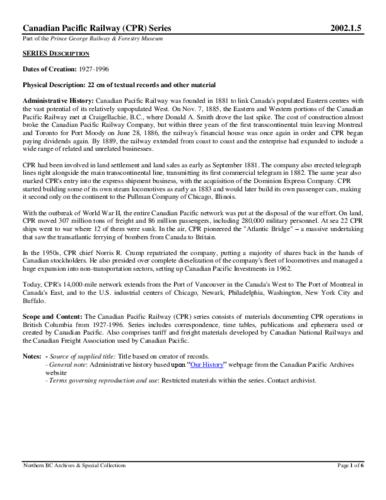Title and statement of responsibility area
Title proper
General material designation
Textual record
Parallel title
Other title information
Title statements of responsibility
Title notes
- Source of title proper: Title based on creator of records.
Level of description
Reference code
Edition area
Edition statement
Edition statement of responsibility
Class of material specific details area
Statement of scale (cartographic)
Statement of projection (cartographic)
Statement of coordinates (cartographic)
Statement of scale (architectural)
Issuing jurisdiction and denomination (philatelic)
Dates of creation area
Date(s)
-
1927-1996 (Creation)
Physical description area
Physical description
22 cm of textual records and other material
Publisher's series area
Title proper of publisher's series
Parallel titles of publisher's series
Other title information of publisher's series
Statement of responsibility relating to publisher's series
Numbering within publisher's series
Note on publisher's series
Archival description area
Name of creator
Administrative history
Canadian Pacific Railway was founded in 1881 to link Canada's populated Eastern centres with the vast potential of its relatively unpopulated West. On Nov. 7, 1885, the Eastern and Western portions of the Canadian Pacific Railway met at Craigellachie, B.C., where Donald A. Smith drove the last spike. The cost of construction almost broke the Canadian Pacific Railway Company, but within three years of the first transcontinental train leaving Montreal and Toronto for Port Moody on June 28, 1886, the railway's financial house was once again in order and CPR began paying dividends again. By 1889, the railway extended from coast to coast and the enterprise had expanded to include a wide range of related and unrelated businesses.
CPR had been involved in land settlement and land sales as early as September 1881. The company also erected telegraph lines right alongside the main transcontinental line, transmitting its first commercial telegram in 1882. The same year also marked CPR's entry into the express shipment business, with the acquisition of the Dominion Express Company. CPR started building some of its own steam locomotives as early as 1883 and would later build its own passenger cars, making it second only on the continent to the Pullman Company of Chicago, Illinois.
With the outbreak of World War II, the entire Canadian Pacific network was put at the disposal of the war effort. On land, CPR moved 307 million tons of freight and 86 million passengers, including 280,000 military personnel. At sea 22 CPR ships went to war where 12 of them were sunk. In the air, CPR pioneered the "Atlantic Bridge" – a massive undertaking that saw the transatlantic ferrying of bombers from Canada to Britain.
In the 1950s, CPR chief Norris R. Crump repatriated the company, putting a majority of shares back in the hands of Canadian stockholders. He also presided over complete dieselization of the company's fleet of locomotives and managed a huge expansion into non-transportation sectors, setting up Canadian Pacific Investments in 1962.
Today, CPR's 14,000-mile network extends from the Port of Vancouver in the Canada's West to The Port of Montreal in Canada's East, and to the U.S. industrial centers of Chicago, Newark, Philadelphia, Washington, New York City and Buffalo.
Custodial history
Scope and content
The Canadian Pacific Railway (CPR) series consists of materials documenting CPR operations in British Columbia from 1927-1996. Series includes correspondence, time tables, publications and ephemera used or created by Canadian Pacific. Also comprises tariff and freight materials developed by Canadian National Railways and the Canadian Freight Association used by Canadian Pacific.
Notes area
Physical condition
Immediate source of acquisition
Arrangement
Language of material
English
Script of material
Location of originals
Availability of other formats
Restrictions on access
Some restrictions apply--contact archivist.
Terms governing use, reproduction, and publication
Personal or academic use of materials is welcomed under the standard fair dealing and educational use clauses of Canadian Copyright Law. Commercial use is, however, forbidden without the express permission of the copyright holder. For information on obtaining written permission from the copyright holder, please contact the Northern B.C. Archives and Special Collections.
Finding aids
Associated materials
Part of the Prince George Railway & Forestry Museum Collection (PGRFM Collection)

